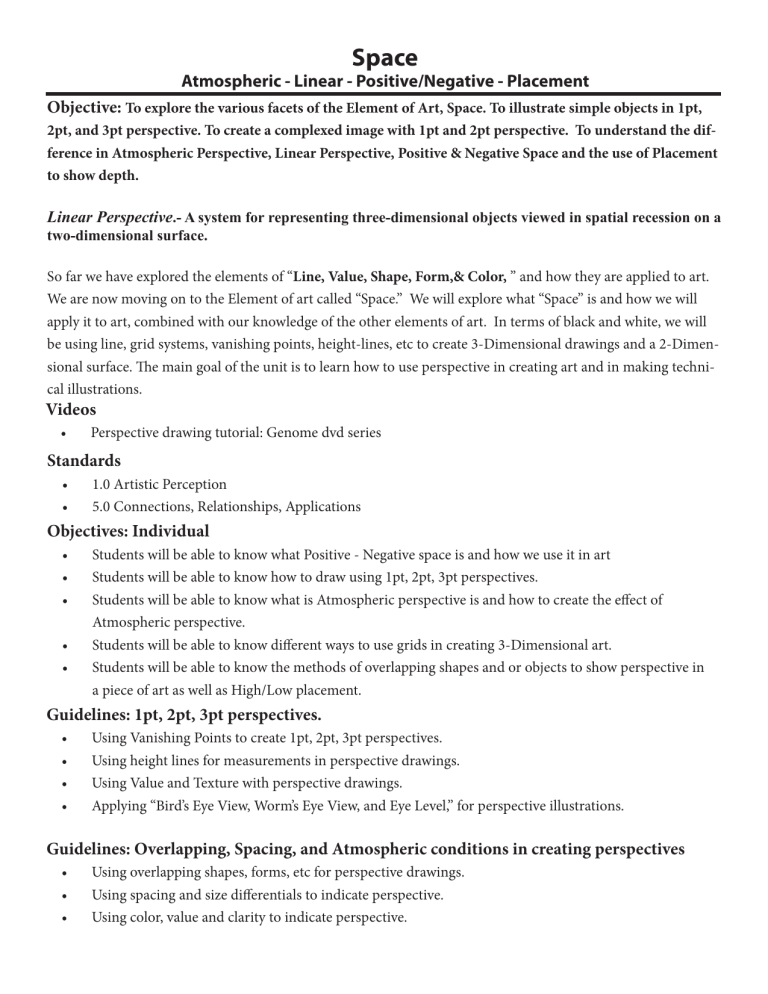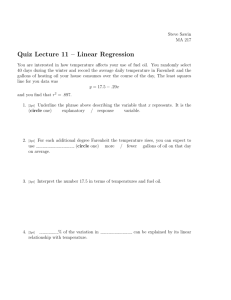Atmospheric - Linear - Positive/Negative

Space
Atmospheric - Linear - Positive/Negative - Placement
Objective: To explore the various facets of the Element of Art, Space. To illustrate simple objects in 1pt,
2pt, and 3pt perspective. To create a complexed image with 1pt and 2pt perspective. To understand the difference in Atmospheric Perspective, Linear Perspective, Positive & Negative Space and the use of Placement to show depth.
Linear Perspective .- A system for representing three-dimensional objects viewed in spatial recession on a two-dimensional surface.
So far we have explored the elements of “ Line, Value, Shape, Form,& Color, ” and how they are applied to art.
We are now moving on to the Element of art called “Space.” We will explore what “Space” is and how we will apply it to art, combined with our knowledge of the other elements of art. In terms of black and white, we will be using line, grid systems, vanishing points, height-lines, etc to create 3-Dimensional drawings and a 2-Dimensional surface. The main goal of the unit is to learn how to use perspective in creating art and in making technical illustrations.
Videos
• Perspective drawing tutorial: Genome dvd series
Standards
• 1.0 Artistic Perception
• 5.0 Connections, Relationships, Applications
Objectives: Individual
• Students will be able to know what Positive - Negative space is and how we use it in art
• Students will be able to know how to draw using 1pt, 2pt, 3pt perspectives.
• Students will be able to know what is Atmospheric perspective is and how to create the effect of
Atmospheric perspective.
• Students will be able to know different ways to use grids in creating 3-Dimensional art.
• Students will be able to know the methods of overlapping shapes and or objects to show perspective in a piece of art as well as High/Low placement.
Guidelines: 1pt, 2pt, 3pt perspectives.
• Using Vanishing Points to create 1pt, 2pt, 3pt perspectives.
• Using height lines for measurements in perspective drawings.
• Using Value and Texture with perspective drawings.
• Applying “Bird’s Eye View, Worm’s Eye View, and Eye Level,” for perspective illustrations.
Guidelines: Overlapping, Spacing, and Atmospheric conditions in creating perspectives
• Using overlapping shapes, forms, etc for perspective drawings.
• Using spacing and size differentials to indicate perspective.
• Using color, value and clarity to indicate perspective.
Space: Vocabulary
Aerial perspective/ Atmospheric perspective .- Aerial or atmospheric perspective achieved by using bluer, lighter, and duller hues for distant objects in a two-dimensional work of art.
Background. The part of the picture plane that seems to be farthest from the viewer.
Balance .- The way in which the elements in visual arts are arranged to create a feeling of equilibrium in a work of art. The three types of balance are symmetry, asymmetry, and radial.
Foreground.
- Part of a two-dimensional artwork that appears to be nearer the viewer or in the front. Middle ground and background are the parts of the picture that appear to be farther and farthest away. focal point. The place in a work of art on which attention becomes centered because of an element emphasized in some way.
Form .- A three-dimensional volume or the illusion of three dimensions (related to shape, which is two-dimensional); the particular characteristics of the visual elements of a work of art (as distinguished from its subject matter or content).
Linear perspective .- A graphic system used by artists to create the illusion of depth and volume on a flat surface. The lines of buildings and other objects in a picture are slanted, making them appear to extend back into space.
Mass .- The outside size and bulk of a form, such as a building or a sculpture; the visual weight of an object.
Middle ground .- Area of a two-dimensional work of art between foreground and background.
One-point perspective .- A way to show three-dimensional objects on a two-dimensional surface. Lines appear to go away from the viewer and meet at a single point on the horizon known as the vanishing point.
Perspective .- A system for representing three-dimensional objects viewed in spatial recession on a two-dimensional surface.
Proportion.
- The size relationships of one part to the whole and of one part to another.
Scale .- Relative size, proportion. Used to determine measurements or dimensions within a design or work of art.
Space.
- The emptiness or area between, around, above, below, or contained within objects. Shapes and forms are defined by the space around and within them, just as spaces are defined by the shapes and forms around and within them.
Three-dimensiona l.- Having height, width, and depth. Also referred to as 3-D.
Two-point perspective .- A system to show three-dimensional objects on a two-dimensional surface. The illusion of space and volume utilizes two vanishing points on the horizon line.
Vanishing point .
- In perspective drawing, a point at which receding lines seem to converge.
Volume. The space within a form (e.g., in architecture, volume refers to the space within a building).
Eygptians using the principle of Overlapping to show
Overlapping and High-Low Placement
Paul Gauguin using Overlapping and High - Low Placement
Atmospheric Perspective (Sometimes called Aerial Perspective)
Atmospheric Perspective (Sometimes called Aerial Perspective)
Atmospheric Perspective in paintings
Linear Perspective
Linear Perspective - 3 Point Perspective
Linear Perspective - 1Point Perspective
Linear Perspective - 2 Point Perspective









